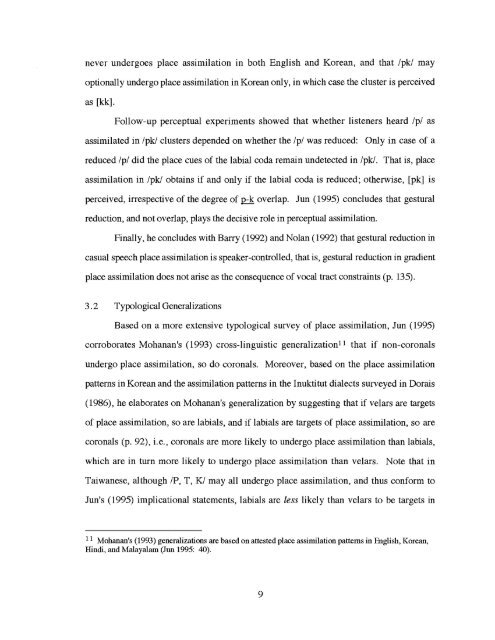A Phonetically-Based Optimality Theoretic Account of Consonant ...
A Phonetically-Based Optimality Theoretic Account of Consonant ...
A Phonetically-Based Optimality Theoretic Account of Consonant ...
You also want an ePaper? Increase the reach of your titles
YUMPU automatically turns print PDFs into web optimized ePapers that Google loves.
never undergoes place assimilation in both English and Korean, and that Ipkl may<br />
optionally undergo place assimilation in Korean only, in which case the cluster is perceived<br />
as [kk].<br />
Follow-up perceptual experiments showed that whether listeners heard Ipl as<br />
assimilated in Ipk! clusters depended on whether the Ipl was reduced: Only in case <strong>of</strong> a<br />
reduced Ipl did the place cues <strong>of</strong> the labial coda remain undetected in Ipk!. That is, place<br />
assimilation in Ipk! obtains if and only if the labial coda is reduced; otherwise, [pk] is<br />
perceived, irrespective <strong>of</strong> the degree <strong>of</strong> p-k overlap. Jun (1995) concludes that gestural<br />
reduction, and not overlap, plays the decisive role in perceptual assimilation.<br />
Finally, he concludes with Barry (1992) and Nolan (1992) that gestural reduction in<br />
casual speech place assimilation is speaker-controlled, that is, gestural reduction in gradient<br />
place assimilation does not arise as the consequence <strong>of</strong> vocal tract constraints (p. 135).<br />
3.2 Typological Generalizations<br />
<strong>Based</strong> on a more extensive typological survey <strong>of</strong> place assimilation, Jun (1995)<br />
corroborates Mohanan's (1993) cross-linguistic generalization 11 that if non-coronals<br />
undergo place assimilation, so do coronals. Moreover, based on the place assimilation<br />
patterns in Korean and the assimilation patterns in the Inuktitut dialects surveyed in Dorais<br />
(1986), he elaborates on Mohanan's generalization by suggesting that if velars are targets<br />
<strong>of</strong> place assimilation, so are labials, and if labials are targets <strong>of</strong> place assimilation, so are<br />
coronals (p. 92), i.e., coronals are more likely to undergo place assimilation than labials,<br />
which are in turn more likely to undergo place assimilation than velars. Note that in<br />
Taiwanese, although IP, T, KI may all undergo place assimilation, and thus conform to<br />
Jun's (1995) implicational statements, labials are less likely than velars to be targets in<br />
11 Mohanan's (1993) generalizations are based on attested place assimilation patterns in English, Korean,<br />
Hindi, and Malayalam (Jun 1995: 40).<br />
9
















